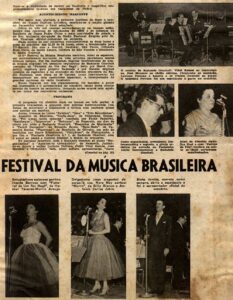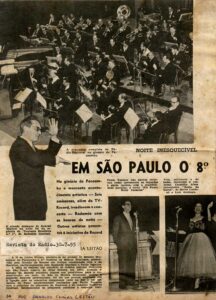- On June 19, in the gymnasium of Estádio Municipal do Pacaembu (SP), the 8º Festival de Música Brasileira, promoted by Rádio Record in collaboration with Rádio Nacional of Rio de Janeiro, and organized by Paulo Tapajós and Radamés Gnattali. The program includes, among other attractions, the Radamés and Aída Gnattali piano duo, which performs pieces by Ernesto Nazareth with arrangements by Radamés. The duo also presents a version for two pianos of Fantasia Brasileira nº1 (from the original for piano and orchestra, from 1937), conducted by Gabriel Migliori.
Radio Magazine (RJ) > 07/30/1955
by Arnaldo Câmara Leitão

- Rádio Gazeta’s Soirée de Gala Antarctica (series of auditions with notable Brazilian composers) is held in São Paulo (SP), presenting the Radamés Gnattali Festival. In program Suíte de Quadros Brasileiros [1], Três Valsas para piano [2]e Brasiliana nº 6 (concerto) para piano e orquestra (1954), conducted by maestro Armando Belardi. On the piano, the author.
- Provided by Continental, Radamés records at Sinter, written by him, with the participation of drummer Luciano Perrone, the Samba in three movements, for piano, string orchestra and percussion typical of the samba schools of Rio de Janeiro (1948). The work was later renamed Brasiliana nº 2.
Brasiliana #2 (Samba in three movements) –
for drums and piano, with string orchestra and Brazilian popular percussion
I – Samba de Morro (excerpt)
Sinter Recordings’ String and Rhythm Orchestra
Lyrio Panicalli, conductor
Luciano Perrone, drums
Radamés Gnattali, piano
- Sinter releases the elepê
Echoes of Brazil
featuring Radamés on piano, with bass and percussion accompaniment, interpreting the sambas Cai-Cai, Estão batendo, Mundo de zinco and the maxixe Rio antigo. - The recording company RCA Victor releases the choro
Soft Talk
by Radamés, interpreted by Canhoto and his Regional. - Elizeth Cardozo records, at Copacabana, the samba
Pra que me iludir
by Radamés Gnattali and Norival Reis. - The Sinter label releases the waltz
Vaidosa
(1947), by Radamés, with the author playing the piano. - The record company Continental reedits in an elepê 78-rpm phonograms recorded in 1951, with Noel Rosa’s songs interpreted by Aracy de Almeida. Arranged, piano and conducted by Radamés.
- Radamés signs the musical direction of the film
Rio 40 Degrees
by Nelson Pereira dos Santos, with Glauce Rocha, Jesse Valadão and a great cast. Músicas de Zé Kéti (A voz do Morro), Moacyr Soares Pereira, João Batista da Silva, entre outros.Ainda em 1955, assume a direção musical dos filmes Angu de Caroço e O Diamante, ambos de Eurides Ramos ; O grande pintor e O feijão é nosso, ambos de Victor Lima ; Eva no Brasil, de Pierre Caron.
- Radamés composes:
Brasiliana nº 9 – for cello and Radamés Sextet
Gnattali
[3] (unfinished work)- Capoeirando (choro) for piano
- Why? (choro) for piano
- Guitarist and composer Garoto (Aníbal Augusto Sardinha, 1915-1955) dies, at 40, in Rio de Janeiro (RJ).
- Juscelino Kubitscheck de Oliveira, from the PSD, former governor of Minias Gerais, is elected president of Brazil.
- Francisco Julião legalizes the Peasant Leagues of the Northeast.
- In Argentina, President Juan Domingo Perón is deposed by a military coup.

